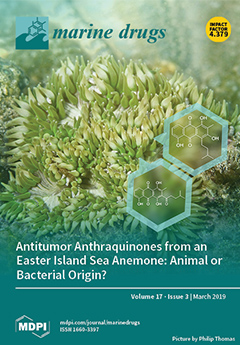The marine alga,
Symphyocladia latiuscula (Harvey) Yamada, is a good source of bromophenols with numerous biological activities. This study aims to characterize the anti-diabetic potential of 2,3,6-tribromo-4,5-dihydroxybenzyl derivatives isolated from
S. latiuscula via their inhibition of tyrosine phosphatase 1B (PTP1B) and α-glucosidase. Additionally,
[...] Read more.
The marine alga,
Symphyocladia latiuscula (Harvey) Yamada, is a good source of bromophenols with numerous biological activities. This study aims to characterize the anti-diabetic potential of 2,3,6-tribromo-4,5-dihydroxybenzyl derivatives isolated from
S. latiuscula via their inhibition of tyrosine phosphatase 1B (PTP1B) and α-glucosidase. Additionally, this study uses in silico modeling and glucose uptake potential analysis in insulin-resistant (IR) HepG2 cells to reveal the mechanism of anti-diabetic activity. This bioassay-guided isolation led to the discovery of three potent bromophenols that act against PTP1B and α-glucosidase: 2,3,6-tribromo-4,5-dihydroxybenzyl alcohol (
1), 2,3,6-tribromo-4,5-dihydroxybenzyl methyl ether (
2), and bis-(2,3,6-tribromo-4,5-dihydroxybenzyl methyl ether) (
3). All compounds inhibited the target enzymes by 50% at concentrations below 10 μM. The activity of
1 and
2 was comparable to ursolic acid (IC
50; 8.66 ± 0.82 μM); however,
3 was more potent (IC
50; 5.29 ± 0.08 μM) against PTP1B. Interestingly, the activity of
1–
3 against α-glucosidase was 30–110 times higher than acarbose (IC
50; 212.66 ± 0.35 μM). Again,
3 was the most potent α-glucosidase inhibitor (IC
50; 1.92 ± 0.02 μM). Similarly,
1–
3 showed concentration-dependent glucose uptake in insulin-resistant HepG2 cells and downregulated PTP1B expression. Enzyme kinetics revealed different modes of inhibition. In silico molecular docking simulations demonstrated the importance of the 7–OH group for H-bond formation and bromine/phenyl ring number for halogen-bond interactions. These results suggest that bromophenols from
S. latiuscula, especially highly brominated
3, are inhibitors of PTP1B and α-glucosidase, enhance insulin sensitivity and glucose uptake, and may represent a novel class of anti-diabetic drugs.
Full article






